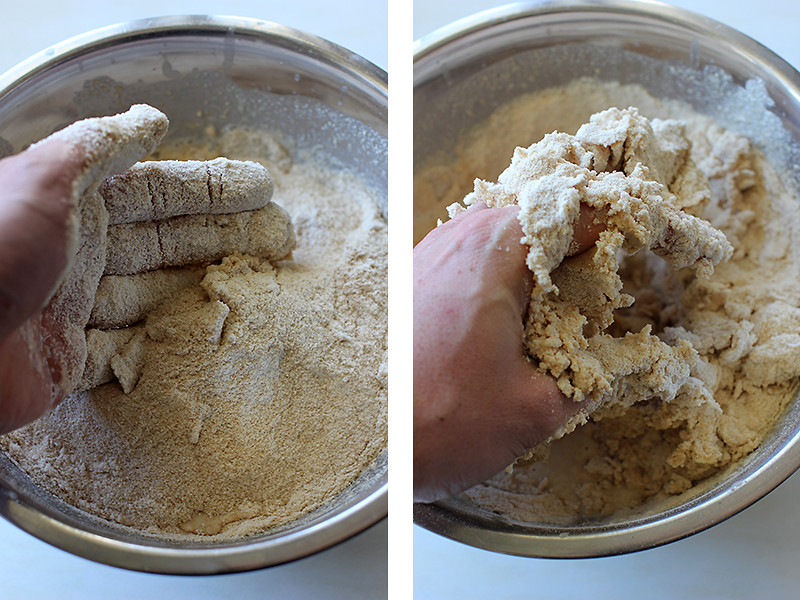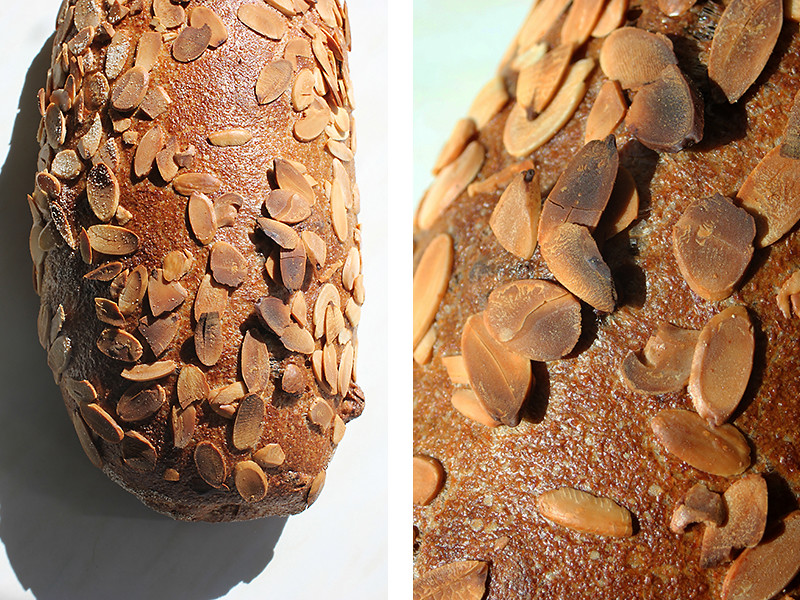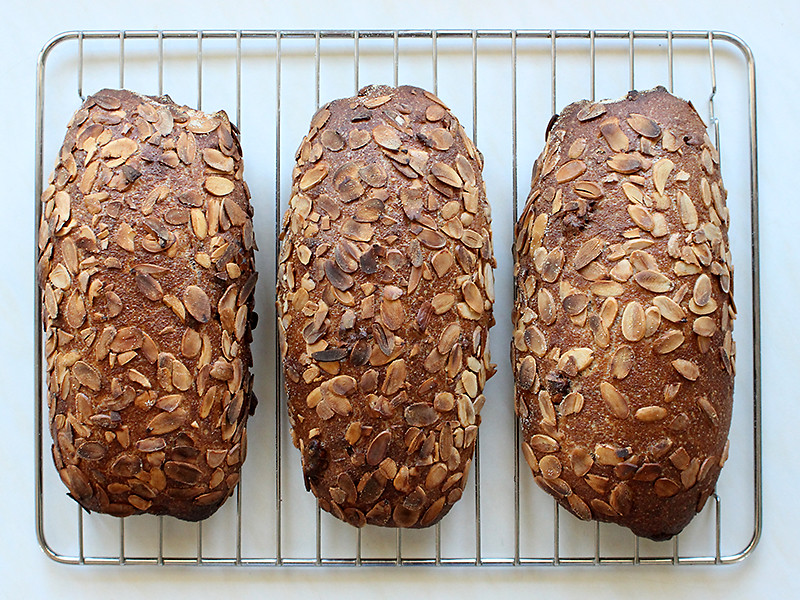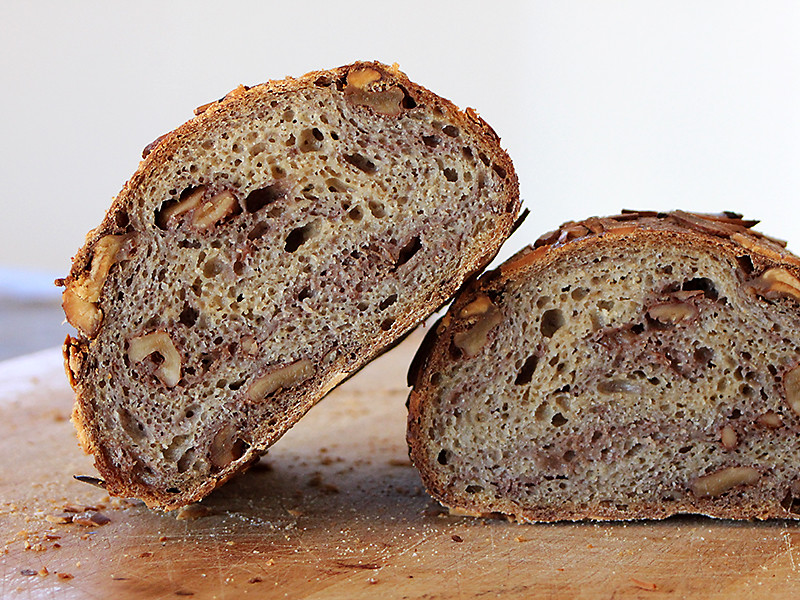
A new prospect is on the horizon.
This new prospect keeps me focused, keeps me pushing, keeps me mixing and baking.
At breakfast and dinner my starter is fed freshly milled flour still warm from its transition from grain to powder. Everyday I watch, smell and taste the starter and notice how temperature and different milling techniques play a role in its development. The biggest change I have ever noticed took place this week when I changed my milling practice.
Reading an article about Dave Miller in the 2012 Spring issue of the BreadLines newsletter I noted that he considered the flow rate of grains into the stones an important factor. I have no control over the high speed of the stones in the Komo mill so perhaps I could control the flow rate rather than just filling the hopper? So began a series of experiments in slow, time consuming milling ... grains trickled into the hopper bit by bit ... and the results?
... I started producing the coolest, finest flour that my little mill has ever produced. The flour was silky to the touch and no heat was created. The change in flour had an immediate effect on the starter feedings ... Water was absorbed more rapidly in the mixing and volume had increased by 10% at the end of a cycle with even aeration throughout.
Unfortunately there was a downside to this milling practice—one I am still to fully understand as I am not an engineer. The mill motor started to overheat quite badly when milling large amounts of grain ... noticeably ... I could smell it ... then it shut off. I had to wait for the motor to cool down before it would switch back on. (I was not even sure if it would) Needless to say I was a little stressed about this!
So I have returned to my normal milling routine of producing high speed, high temperature flour, but all the time thinking of ways to slow this process down.
[url=http://www.flickr.com/photos/67856223@N06/9055537510/] [/url]
[/url]
[url=http://www.flickr.com/photos/67856223@N06/9055536964/] [/url]
[/url]
[url=http://www.flickr.com/photos/67856223@N06/9053311145/] [/url]
[/url]
I came to the idea of utilising freshly milled grains by the way of Gerard Rubaud and his unending quest for flavour. This was a completely new idea for me having only been exposed to bags of flour sitting on store shelves.
So I bought a small stone mill and from that moment when I first experienced fresh, sweet whole grain flour I knew I was hooked.
This ever increasing fascination in stone milling and how it can work within a bakery environment has been furthered along by the likes of Dave Miller of Miller's Bakehouse in Yankee hill. For Dave the mill is a necessary part of his bakery set up. His holy trinity he calls it - mill, mixer and oven. He is a one man show and for me is the epitomy of the local village baker. The wheat is grown, milled and made into bread—all locally.
[url=http://www.flickr.com/photos/67856223@N06/9053310525/] [/url]
[/url]
[url=http://www.flickr.com/photos/67856223@N06/9055534968/] [/url]
[/url]
In the BreadLines newsletter Dave contributed a formula for his 'Chico Nut Bread'. Chico, California where Dave sells his bread is surrounded by walnut and almond orchards ... "a natural choice for whole grain doughs" says dave.
I was excited by this bread ... a walnut sourdough is one of my favourite breads to both make and eat.
A glance at Dave's formula can prove more daunting than the actual feel of the dough ... he uses a lot of water with his fresh milled whole grains. But remember, the formula is not the bread—feel the dough and trust that it will come together. It also seemed that only Californian walnuts were available from my local shops ... so perhaps my bread would be closer to California than I thought :)
[url=http://www.flickr.com/photos/67856223@N06/9055534396/] [/url]
[/url]
[url=http://www.flickr.com/photos/67856223@N06/9055533754/] [/url]
[/url]
[url=http://www.flickr.com/photos/67856223@N06/9055533310/] [/url]
[/url]
Chico Nut Bread courtesy of Dave Miller
Formula 6 x 700g
| % | Weight grams |
Levain build – 3 hrs 26°C |
|
|
Starter | 50 | 93 |
Freshly milled organic wheat flour | 100 | 187 |
Water | 64 | 120 |
|
|
|
Final dough - 24°C |
|
|
Levain | 20 | 325 |
Freshly milled organic wheat flour | 100 | 1626 |
Water | 109 | 1772 |
Salt | 2.50 | 41 |
Toasted Walnuts | 26.85 | 437 |
Sliced Almonds | As needed |
|
Total |
| 4200 |
This is my adaptation of Dave’s process for home baking.
- Mix final starter and leave to ferment for 3 hours at 26°C
- Mill flour and mix with water (hold back 10% of water) and autolyse for 20 mins.
- Add starter to autolyse then mix in bowl for 5 mins. Add salt and remaining 10% of water and squeeze through bread to incorporate (dough will separate then come back together) then mix and squeeze a further 5-10 mins. The dough is very wet but should start to feel some strength by the end of this mixing.
- Add walnuts at the end of mixing.
- Place in a fridge at 4°C for 15 hours. I gave the dough a fold at 30mins and 1.5 hrs.
- Increase or decrease the number of folds depending on the strength of your wheat.
- Remove from fridge. Divide at 700g. Preshape.
- Bench rest 45–60mins. Shape and roll the dough on a wet cloth and then in sliced almonds. Proof in couche or narrow basket.
- Final proof was two hours at room temperature. Watch the dough!
- Bake in a preheated oven at 250°C for 10 mins with steam. Reduce temp to 200°C then bake for a further 40 mins.
[url=http://www.flickr.com/photos/67856223@N06/9055532560/] [/url]
[/url]
[url=http://www.flickr.com/photos/67856223@N06/9055531404/] [/url]
[/url]
[url=http://www.flickr.com/photos/67856223@N06/9053305013/] [/url]
[/url]
Work quickly, utilise your scraper and be brave! This is the most alive feeling wholegrain dough I have ever made. It is a little hard at first to believe the amount of water that is being poured into the bowl and even after the autolyse I was nervous.
Mixing is the only way to describe the initial dough development. I dared not take it out of the bowl and used both hands to squeeze, fold and turn the dough … it’s not until you perform folds during bulk ferment that you feel the strength really increase.
The long cool bulk ferment also allows for maximum water absorption and makes handling the dough a little easier the following day!
[url=http://www.flickr.com/photos/67856223@N06/9055529642/] [/url]
[/url]
[url=http://www.flickr.com/photos/67856223@N06/9053303703/] [/url]
[/url]
[url=http://www.flickr.com/photos/67856223@N06/9055528178/] [/url]
[/url]
The toasted almonds scattering the outside makes for beautiful looking bread bursting with texture and aromas … but it was the taste that won both Nat and myself.
The walnuts and almonds flavours almost seem to merge and it’s hard to distinguish between them—making indeed a true ‘nut bread’. The walnuts give the crumb a creamy texture and it’s characteristic purple hue. We love this bread toasted until the walnut pieces turn white within that coloured crumb.
[url=http://www.flickr.com/photos/67856223@N06/9055527482/] [/url]
[/url]
[url=http://www.flickr.com/photos/67856223@N06/9053301135/] [/url]
[/url]
[url=http://www.flickr.com/photos/67856223@N06/9053300143/] [/url]
[/url]
Winter has arrived here with cool days and nights which are just perfect for baking ...
Happy baking everyone.
Phil
- PiPs's Blog
- Log in or register to post comments
Hey Phil. These are something new! Never even though to put sliced almonds on the crust. One of my favourite nuts so I can imagine this being a bread I would enjoy. The crumb looks great. Kind of in the dumps today as my 50% rye loaf crumb did not turn out. Nor did the flavour. I fear that the rye flour I used might be a bit off. First taste of the bread has an unpleasant Playdough-ish taste. Have you had this kind of flavour ever come out? These photos sure get my willingness up to keep trying and keep trying more.
Thanks for this.
John
Thanks John,
I think the almonds are a great touch ... adds a lot to this bread.
It's been a long time since I have eaten playdough :)
Hard to say without seeing the bread and formula ... I have heard that wholegrain rye flour has a tendency to spoil quicker. Was most of the rye flour in a sourdough starter or added in the final dough?
Keep trying!
Cheers,
Phil
I won't rule out the flour being off even though the seeds are clearly a bit off as well.
The rye flour I used was purchased about 2 and half months ago. Fresh milled organic medium rye. All of the rye was in a rye sour preferment. Very similar to the 40% rye formula you posted a while ago.
As long as you keep posting beauties such as these, I will keep trying :)
John
Oh no. I just tasted a handful of the sunflower seeds I used in the loaves today and they tasted a bit off. Purchased ad opened the package 3 weeks ago while on vacation. No doubt the soaking process brought out that flavour even more. That's the last time I use pre-roasted pre-packaged seeds/nuts into my breads. Ugh....
Anyway, sorry for the off-topic blurb. Did I mention nice loaves??? :)
John
Ahh ... that sounds like it ... eww ... I can only imagine ... soaked and soggy off seeds.
Cheers,
Phil
I feel bad for going off topic, taking away from the star of the show. Phil's amazing bread!
Also, Phil, did you mean for the marbled colour to happen? I know it is from the walnuts, but did you know that it would turn out in such a nice marbled kind of look? Very nice feature to the crumb.
John
for Aussies - meaning matey! Loosely translated (and I mean loosely) this would be 'Crazy Mates' bread. Personally I think it needs some fresh sage so it could transform into Superhero Hulk Bread but that is another Phil bread entirely and we like that one too.
Nice baking Phil. The crust and crumb are just beautiful. This bread has to be tasty. Love the pix's too.
Happy baking,
Thanks mate :)
Our sage plant has bitten the dust recently ... so no sage in the walnut breads for a while.
Strewth*, this is a bloody tasty bread!
Cheers,
Phil
* Strewth - An Australian, or "Aussie", exclamation, similar to the somewhat more popular "Crikey!"
Chico is only 3 hours I'll have to check this bakery out.
Another fine post Phil and beauty of a bake,
I'm gonna have to go on a road trip
Josh
Hey Josh,
Lucky you!
Think Dave sells his products at the Chico Farmers Markets ... would be well worth your time.
All the best,
Phil
I would not dare push my mill motor to that extent. But i'm really interested in the method. Too bad the flour can't be reliably duplicated.
The breads are absolutely gorgeous, Phil!! Perfect for snack.
-Khlalid
I still can't see how just grinding a slow trickle of grains as opposed to filling the hopper would cause the motor more stress apart for the fact that it would be running a little longer. When just grinding the amount I need to feed the starter I didn't have any issues ... the overheating came about when trying to mill a decent amount for some bread.
It did make a difference though ...
All the best Khlalid
Phil
Phil, that is a very nice bread. My little girl keeps pointing at your pictures as I was reading your posts and said: mum ... mum ... yumm...yumm!
I think I will have to make this bread tomorrow.
Thank you for your recipe.
Cheers,
Annie
Thanks Annie,
Hope your daughter likes it :)
Even after dinner the kids here have been eyeing of the bread and harrassing us for a slice ... breakfast tomorrow!
All the best,
Phil
Thanks Evon,
The rice grinding sounds fascinating ... very different from the dry dusty flour milling which messes up my kitchen :)
I will have to do some reading about the love letter biscuits ... I have never heard of them.
I use fresh sage in the walnut dough. I have a blog post from a while ago for a walnut and sage wholewheat ... It's a nice combo.
http://www.thefreshloaf.com/node/27219/tartines-aromatic-semolina-bread-walnut-and-sage-wholewheat
All the best,
Phil
thoughts about milling. Maybe there is a middle ground that would work for both the flour and the mill. I am always upset when my flour comes out hot from the mill, and slap it into the freezer right away to cool down. Would be much better not to get it hot in the first place. Your bread looks lovely and very nutty. -Varda
Well done again Phil!
Is the mill under warentee? Contact the maker and tell them the issue. Ask them if the have a mill that you could upgrade to that has a varible speed function. OR, take the mill to a good repair shop and ask if they could put in a Voltage regulator so you can control the speed of the motor. OR, ask them if they have a suggestion based on the motor itself that could meet your needs. OR, put the whole mill in the chiller/fridge overnight and try grining again. Maybe starting the grind with all of the components cold will keep the overall temp low enough to get through the milling process.
Just a few idea mate, hope they help,
Cheers,
Wingnut
Thanks for the ideas Wingnut,
I get cooler flour if I store the grains in a fridge or freezer ... but this also changes the way the grain is milled. They shatter more.
Think I might drop Komo a message and keep experimenting ...
Cheers,
Phil
Hi Phil,
Great discovery. I love byronfly's explanation as to what is happening.
I know with my KoMo they do warn about the stones overheating in the 'manual' "Do not leave running without wheat in the hopper" - or some such wording so I am always careful to be within hearing distance to shut it off when it is done. I attributed that warning to wearing down the stones though....not a motor issue. Perhaps it is both? I also mill outdoors now to keep the dust out of the kitchen. Wonder if you can mill in small batches throughout your day? Would be pretty time consuming and you would still run into the stones creating too much friction by their touching each other. Always a new puzzle to solve. I look forward to hearing your solution :^ )
Loaves look really tasty. I am surprised by how well they kept their shape with that much water! I go that high if adding fruit that will absorb a lot of water but usually nuts - especially the kind used in this bread - do not require a lot extra....I will have to do some experimenting as my curiosity has been peeked.
Thanks for the photos - always so lovely to simply gaze upon.
Take Care,
Janet
Thanks Janet
I never have the stones touching so I don't think it can be that ... you are probably right in mentioning the motor running for longer times. I wonder if the hopper being full slows the stones slightly with the large mass of grains pushing against the stones. Without that weight of grains the motor spins quicker and has a tendency to heat up perhaps?
The amount of water used has made some of the nicest eating wholegrain bread ... easy to digest ... doesn't feel heavy or burdening.
Cheers,
Phil
Humm....too bad we can't have this conversation with the makers of the mill. I am sure there are lots of little tidbits about optimal functioning that we are totally unaware of. I do think the 'don't leave the mill running....' caution has to do with the motor as the manual specifies NOT allowing the stones to touch at all.....
I did try milling my leaven flour (200g) this morning using your guidelines. No overheating but 200g isn't that much grain. I didn't notice any difference in the outcome though with the grain I mill 'all at once'. Both were fine and bran size was the same...Do you run your grains through several times? I mill on as fine of a setting as the stones allow and I only mill once with wheats etc...Only time I mill several times is with corn.
I have toyed with the idea of a hand mill but I have a flaker and know how time consuming it is to hand grind. Not sure the benefits would outweigh the inconvenience for me so I haven't added one to my stash of baking toys tools.
Forgot to mention on your other blog so I will mention it here....I have been doing 'bold' bakes when baking lean loaves and the people I have been giving them to do enjoy the dark crust with the moist crumb.....thanks for the nudge *- }
Take Care,
Janet
Although it does make the arguement for the hand turned mill - say -oh - a Diamant.
Although I recently purchased a Komo - well, we just don't need to discuss the chaos that reigns in my life right now and has for some time - I have not yet used it. Frankly I was used to the flour coming off the mill cool. Spoiled, I am.
Nice bread. good pics...:>)
Pat
Oh dear ...
I think you may know me too well ... I have been eyeballing the Grainmaker 116 mill for the past few days.
I have bigger plans for a larger mill in the future ... but I like the level of control you would get with a small hand cranked mill.
All the best Pat,
Phil
as someone who is over the top in love with the Diamant - if I were buying a hand cranked mill at this point in time I would give serious consideration to the Grainmaker. When I bought my mill the Grainmaker mill (only one..) and distribution network were in their infancy and the Diamant was the obvious choice. Now? The love story may have taken quite a different turn. Those Grainmakers seem to be some nice mills. They also sell a motorization package which I speculate might provide enough capacity for a micro-bakery.
BTW: How 'bout scheduling a fall trip to Sin City for IBIE? I went to the last one and it was pretty great (not as cool as Europain, though)... I should be doing some work for the BBGA (if they have forgiven me for "The Generosity of Bakers" blog entry which got me in deep hot water...)
Hi Phil. I was tempting to get one Tribest Wolfgang Flour Mill on Ebay. Have you been using this flour mill before or if you know anyone who is using it? Also if you could please recommend some of the flour mill that you have been using. I have been to one of the Thermomix demo, just didn't like it.
Thanks Phil
Annie
Hi Annie,
I believe the Wolfgang and Komo are the same product. I purchased my Komo direct from the company in Germany so I could ensure the correct power setup for Australia.
I would have a look at Skippy Grain Mills in Australia as they have a wide range of mills and you should find something that suits your needs and budget. My father bought a Hawos Billy from them and said the service was great. He is very happy with his mill.
http://www.skippygrainmills.com.au/
I actually think the Hawos Billy produced a nicer flour than my Komo ... but I have never had the chance to use them side-by-side.
Cheers,
Phil
I will look up the Hawos Billy. Another question, is the hand grinder good?
thanks Phil
and interesting discussion. This sounds like a challenge I might take up, especially with all these wonderful nuts.
I have an elecric Nutrimill and a hand-cranked Junior. It is a great workout for your arm muscles, and I use it mainly to make coarse grinds. But milling any larger amount of flour in the hand-cranked mill - only if you are a masochist or want to risk a tendinitis.
Karin
I just wondered and now I know it's not my "type".
Annie
Hi Phil,
Great bread! I'm unsure of the flour used. Is it whole wheat, white whole wheat, or white wheat?
ml
Hi ml,
I am milling white winter wheat which is widely grown in Australia.
cheers,
Phil